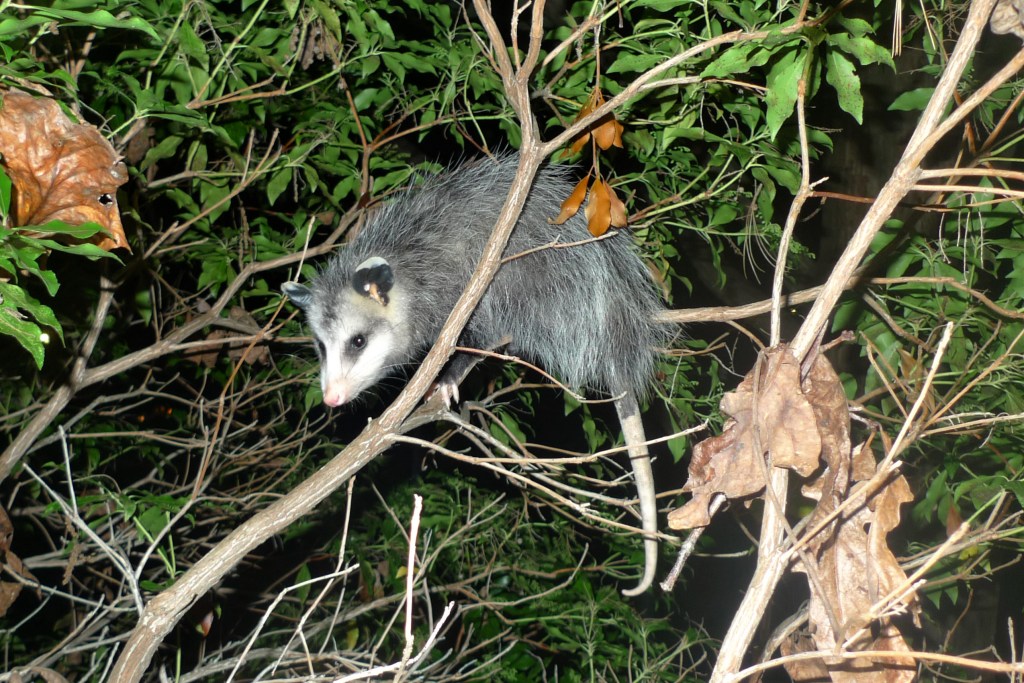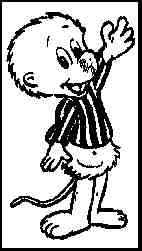
Common Name: Opossum, Opossum, Possum, Common opossum, Virginia opossum – The name is of Native American provenance and is from the Algonquian word apasum, which translates as “white animal.” The coarse fur ranges from white in the northern reaches of its range to almost black in warmer regions.
Scientific Name: Didelphis virginiana – The generic name is from the Greek di meaning “two” and delphys meaning “womb.” The opossum is a marsupial with a pouch that is used to nurture the young after gestation; it is metaphorically a “second womb.” An alternative etymology for the genus is the fact that the female opossum has two uteruses. The species name refers to its original identification and description in the colony of Virginia by European naturalists defining the taxonomy of North American fauna.
Potpourri: Opossums are the only marsupial mammals in North America; there are none in Eurasia. They are in a sense living fossils, transitional forms that link the more primitive egg-laying monotreme mammals to those with a placenta. The global geographic dispersion of marsupials is a biological affirmation of continental drift and its plate tectonic motive force. They predominate in the Australian archipelago with their monotreme brethren and are well established in South America. Opossums arrived in North America as relatively new immigrants across the Panamanian isthmus when the two continents became conjoined about 2.8 million years ago; only yesterday in geological time. That they thrived amid the dominant placental mammals is testimony to their resilience and adaptation. This is especially noteworthy considering that they lack any form of plates or spines to protect their scrawny bodies and possess neither fangs nor claws to repel an attacker. Their most effective defense is to feign death, giving rise to the idiom “playing possum.”
Evolution rarely if ever proceeds in a straight line―it is a record of the past but not a plan for the future. Random mutations yield periodic variations on the original theme; only a precious few result in an intelligent design that endures. Nature is the judge and every other living thing is the jury as newness strives for an unoccupied niche. The original mammal combined three key attributes that together resulted in permutation and dominance: warm blood; milk glands; and body hair. The last common ancestor of mammals and reptiles lolled about in muddy wetlands about 300 million years ago. It took 100 million years to make a mammal and another 20 million years to make a monotreme, the most primitive of extant mammals. Monotreme means ‘one-hole’ as they have a single cloaca, the external passage for intestinal, reproductive and urinary purposes, a trait shared with birds and reptiles. Cloaca means ‘sewer’ in Latin. The scant fossil record indicates that there was a proto-monotreme named Australosphenida that spread out over the continents that originally formed Gondwana, the southern portion of Pangaea. [1]
Only five monotreme species survived the scourge of extinctions caused by competitors, environmental changes, and cataclysms. The inimitable duck-billed platypus and four echidnas or spiny anteaters are the only surviving representatives. These animals stymied taxonomists for more than a century due to uncertainty about lactation and reproduction. They lack prominent nipples and they produce offspring infrequently and in seclusion. When the first platypus was sent to England in 1799, it was thought to be a hoax due to the improbable combination of a bird-like beak, the four feet of a quadruped, and a fishy aquatic habitat. The lactation issue was resolved by a British Army Lieutenant in New South Wales named Maule who skinned his pet female platypus after she was accidentally killed and noted milk emanating directly from her abdomen. When this report reached London, the testimonial of an army officer was considered unimpeachable and the platypus was declared mammalian in 1831. The reproductive question was not resolved until 1884 when a British zoologist named Caldwell had killed over 1400 monotremes to try to solve the riddle of reproduction. His brutal quest ended when he came across a female in the process of laying eggs. [2] The monotreme was confirmed as mammalian.
The importance of monotremes was noted by Darwin during his brief sojourn in Australia in 1836 during the seminal circumnavigation of HMS Beagle: “I had the good fortune to see several of the famous Platypus or Ornithorhyncus paradoxicus; certainly, it is a most extraordinary animal … A little time before this, I had been lying on a sunny bank and was reflecting on the strange character of the animals of this country as compared to the rest of the world.” [3] Some years later, he wrote “We here and there see a thin straggling branch springing from a fork low down on a tree, and which by some chance has been favored and is still alive on its summit.” [4] The platypus was pivotal to Darwin’s tree branch conceptualization of evolution. He was, in fact, consistent in his perspicacity throughout, as the dearth of fossils indicate that monotremes are, indeed, a straggling branch. They are the egg-laying mammals that evolved from the reptiles as lactating nurturers, setting the stage for the successor marsupials, the pouched mammals; marsupium is Latin for pocket.
Marsupial mammals are considerably more common than monotremes with about 330 species almost exclusively in Australia which has four orders and South America which has three. These groupings are sometimes referred to as Australidelphia and Ameridelphia. Marsupials are phylogenic with placental mammals in having a single common ancestor after the branching of monotremes. To emphasize these relationships, the older monotremes are designated Prototheria, the more recent mammals Theria, marsupials are Metatheria, and placentals are Eutheria. The range and diversity of marsupial mammals offers one of the most compelling arguments for the veracity of Darwin’s epiphany about the origin of speciation. Evolution is only a theory according to scientific rules that require experimental validation and the clock cannot be set backward to precursors nor can it be sped up from geologic to human time to prove it. A great many marsupials independently adapted over time to have the same body forms as placentals, a phenomenon called coevolution. The Tasmanian Devil is a pouched carnivore; kangaroos, koalas, and wombats are pouched herbivores. There are marsupial moles and anteaters in addition to Thylacine, an extinct marsupial dog and Thylacoleo, an extinct marsupial lion. The independent evolution of sophisticated pouched mammals upends the widely held view that placental mammals are superior to marsupials. They are in reality a separate and essentially equal branch of the family tree with all of the necessary attributes to establish them as members in good standing of class Mammalia. [5]
The fossil record of the marsupial Metatheria provides a geographic date stamp for the breakup of Pangea punctuated by the Cretaceous-Paleogene (KPg) extinction event 66 million years ago. The oldest marsupial fossil found so far is from northeastern Eurasia in 125 million year old sedimentary rocks. The first Eutherian/placental fossil is “only” 35 million years older. All of the other extant Metatherian fossils from the Mesozoic Era are from the northern continents of Laurasia, there are none in South America or Australia. In that this is their present habitat, mass migration must have occurred. The oldest marsupial mammal fossil in South America is 64 million years ago, indicating that it had crossed from North America when the two were connected for some time by a land bridge; The KPg extinction event must therefore have extirpated the northern non-migratory marsupial contingent while the Eutherians prevailed. The current theory is that marsupials from South America crossed to Australia via Antarctica, when they were contiguous at temperate latitudes about from 55 to 35 million years ago; 45-million-year-old marsupial fossils have been found off the coast of Antarctica. As the only mammals in Australia, the Metatheria flourished as the climate changed from rainforest to open woodlands during the Miocene Epoch, producing marsupial megafauna in parallel with the placental megafauna of North America. Ten-foot kangaroos bounded about with giant koalas and a huge rhinoceros-like marsupial. The larger marsupials became extinct shortly after the arrival of the Aborigines about 40,000 years ago, the same fate that befell their placental brethren coincident with the arrival of the Native Americans 12,000 years ago. While predation by human hunters played a role in these extinctions, it was mostly a matter of environmental, climate-related habitat changes. The smaller marsupials, like the opossum, survived and thrived, and one species moved north to become the Virginia opossum. [6]
Opossum is from the Powhatan dialect of the Algonquian language group, a variation of oposoum meaning “white animal,” its coarse fur ranges from white in the northern reaches of its range to almost black further south. Captain John Smith, one of the founders of the Virginia colony at Jamestown in 1607 described an animal that “hath an head like a swine … tail like a rat … and the bigness of a cat” in a compiled list of Native American words. [7] It was officially classified it as Didelphis virginiana from the Greek di meaning “two” and delphys meaning “womb,” as the females have two uteri, a trait shared with all marsupials, with Virginia as locale of first siting. While not as chimerical as the platypus, opossums do not lack distinction. Their pointed white faces and piercing, beady black eyes appear ghostly and ghoulish, particularly after dark when such things are imagined. The reverie is not diminished by the demonic prehensile tail that extends for half its body length. The caudal appendage is simian in form and function, adapted to grasping branches for balance and leverage in establishing tree cavity nests. Arboreal acrobatics are further enhanced by opposable thumbs on their hind feet, an attribute they share only with primates and a very few other species, mostly marsupial mammals. The satanic image is complete with the thoroughly fanged jaw that smiles with reptilian menace with a display of fifty teeth, more than any other North American mammal. For the Europeans who first came to the Americas in the sixteenth century, the opossum was sui generis and of consequent great interest.
Vicente Pinzón, the commander of Christopher Columbus’s ship Nina, brought an opossum back to the Spanish regents Ferdinand and Isabella, describing it as a “monster” with the “hinder of a monkey, the feet like a man’s, with ears like an owl; under whose belly hung a great bag, in which it carried the young.” As the Europeans had never seen a marsupial (there are none in Eurasia or Africa), the opossum came to epitomize the exotic fauna of the Americas. [8] The German cartographer Martin Waldseeműller, renowned for his assigning the name America on a 1507 world map drawn from information gathered on the voyages of Amerigo Vespucci, included the opossum in a later woodcut as an evocative symbol of the New World. Sixteenth Century engravings of the opossum, such as Étienne Delaune’s “America” depicted the peculiar animal with sharp fags and exaggerated claws. Over the course of the next century, the myriad novel plants and animals of the New World inspired the nascent science of comparative anatomy and ultimately to the evolutionary ideas of Darwin. The opossum was transmogrified from monster to mammal by Edward Tyson of the Royal Society who described the anatomy of the female opossum in a treatise in 1698. He correctly surmised that the “feet like a man’s” were for grasping and the “great bag for the young” was a manifestation of maternal care. [9] The opossum was redeemed.
That the Virginia opossum is the only marsupial to thrive in North America is testimony to its synanthropic nature, thriving in and around human habitation. Consequent to their omnivorous adaptability, fecund reproduction and creative, steadfast defenses against predators, they proliferate. Opossums can and will eat almost anything that is organic, including but not limited to insects, snails, small mammals, fruit, eggs, fledgling birds, and, on occasion, cultivated crops. Those who choose to leave pet food or any other scraps in accessible areas will soon attract the attentions of opossums. They make their home nests as a sequestered sanctuary for their brood in the hollows of trees, taking advantage of prehensile tails and grasping rear feet to navigate the arboreal habitat. The female opossum is fertile at the age of six months and can have two litters every year; the gestation period is only about two weeks. The young are not born in the pouch but instinctively crawl there from the uterus; this is no mean task as they are blind, furless and bee-size, weighing 100 milligrams. Those that make it seek out one of 13 nipples (twelve in a circle around one in the center) to which they are nurtured for several months. Although senescence is rapid (the average life span of an opossum is only about 3 years), the population is adequately replenished by the number of joeys and the nurturing nature of the species. [10]
Opossums are peerless masters of pantomime, the idiom “playing possum” a linguistic testimonial. They must be, as they lack innate physical defenses like porcupine spines, armadillo shells or bobcat claws, are not very fast, and don’t burrow in hidden dens. When cornered, an opossum will play dead so realistically as to dissuade even the most determined predators. The mimicry is quite convincing. Stiffened in feigned rigor mortis, teeth bared in the throes of death with the putrid smell of a cadaver from mephitic fluid emitted from glands near the anus; they look, feel and smell like a dead animal. They stoically endure bashing, scratching, and biting remaining mute and motionless until the ruse prevails and the assailant retires. Healed scars are the only evidence of a protracted struggle. A rabid pretense defense is used to deter aggression from less egregious threats. The symptoms of rabies are simulated by secreting excessive saliva at the corners of the mouth with the lips drawn baring the full suite of sharp teeth. In addition to overt defenses, opossums have covert protection of an immune system that evolved resistance to the venomous bite of pit vipers, a property first discovered and patented in 1996. Due to the small number of snakebite victims in the United States and the expense of synthesis, there was no incentive at that time to exploit opossum-based antivenom. With the advent of biomedical engineering, an E. coli bacterium was modified to produce the necessary opossum peptides at a price affordable enough for potential use in India, where there are over 100,000 snakebite deaths every year. [11] Opossums have succeeded against all odds with a combination of chemistry and comic opera, surviving as the fittest.

Like the bison and the turkey, the opossum is an iconic native North American animal. It embodies the spirit of the continent as the home of immigrants, including those of Native American heritage whose Asian genetic heritage is only some 12,000 years removed, almost yesterday in the grand swath of earth-time. The opossum is an equally itinerant immigrant as the only marsupial amid a menagerie of competitive placental mammals of equal need to eat and reproduce. The ‘possum’ is central to the cultural cuisine of Appalachian and Ozark hill country, where it is hunted as a game animal and consumed as a choice entree according to recipes that have endured for generations. In January of 1909, President-elect William Howard Taft was served an eighteen-pound possum for dinner while visiting Georgia and was quoted in a New York Times article as having remarked “Well, I like possum, I ate very heartily of it last night.” Numerous live opossums were sent to the White House from his southern constituents in consanguinity. A stuffed “Billy Possum” was created as an alternative to Roosevelt’s established “Teddy Bear,” which was also occasioned by a newspaper article. However, cuddly is an oxymoron for the rat-like, sneering possum and sales failed to meet expectations. [12] Walt Kelly’s Pogo is perhaps the most notable cultural testimony to the opossum; the kindly denizen of the Okefenokee Swamp famously said, “we have met the enemy and he is us” in the poster Kelly made for the first Earth Day in April 1970.
References:
- Weisbecker, V. and Beck, R. Marsupial and Monotreme Evolution and Biogeography. Nova Science Publishers, 2015
- Drew, L. I, Mammal the Story of What Makes us Mammals Bloomsbury Sigma, London, 2017. pp 41-60.
- Keynes, R. D. ed. Charles Darwin’s Beagle Diary. Cambridge University Press. 1988.
- Darwin, C. Journal of the Researches into the Natural History and Geology of the Countries Visited during the voyages of HMS Beagle Round the World, John Murray, London 1845.
- Weisbecker, V. and Beck, R. Op. cit.
- Ibid.
- Mithun, M. The Languages of Native North America. Cambridge University Press. 2001 p. 332
- https://www.motherearthnews.com/nature-and-environment/opossum-facts-behavior-and-habitat-zmaz03aszgoe
- Tyson, E. “Carigueya Seu Marsupiale Americanum, or The Anatomy of an Opossum, Dissected at Gresham-College by Edw. Tyson, M. D., Fellow of the College of Physicians, and of the Royal Society, and Reader of Anatomy at the Chyrurgeons-Hall in London,” Philosophical Transactions of the Royal Society April 1698 no. 239 p 102
- https://opossumsocietyus.org/general-opossum-information/opossum-reproduction-lifecycle/
- Davenport, M. “Opossum Compounds Isolated to Help Make Antivenom, Scientific American March 2015.
- Fuller, J. “Possums and Politicians? It’s Complicated.” Washington Post, 24 Sep 2014.
